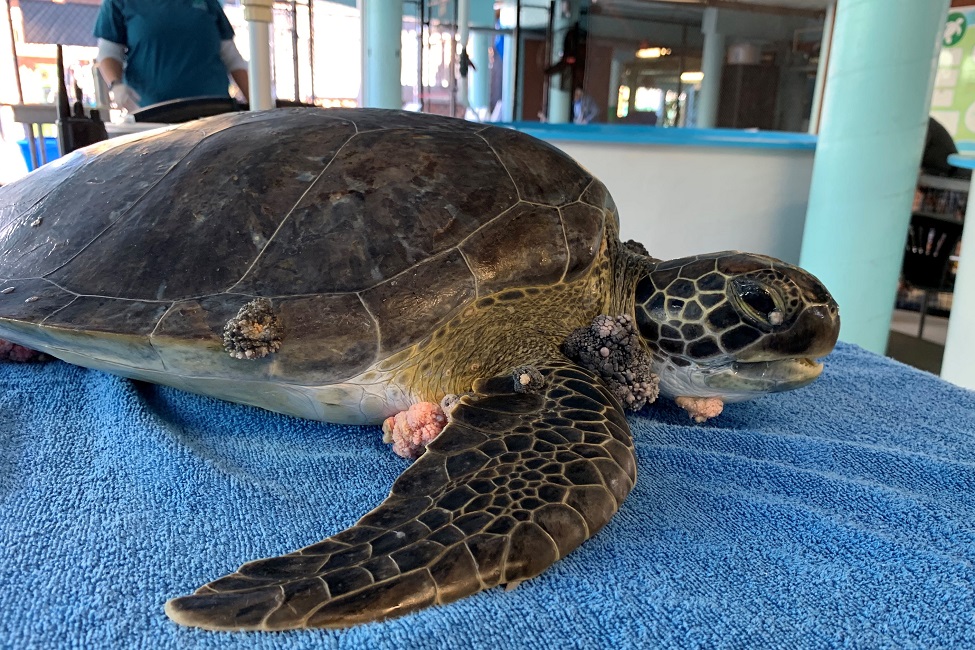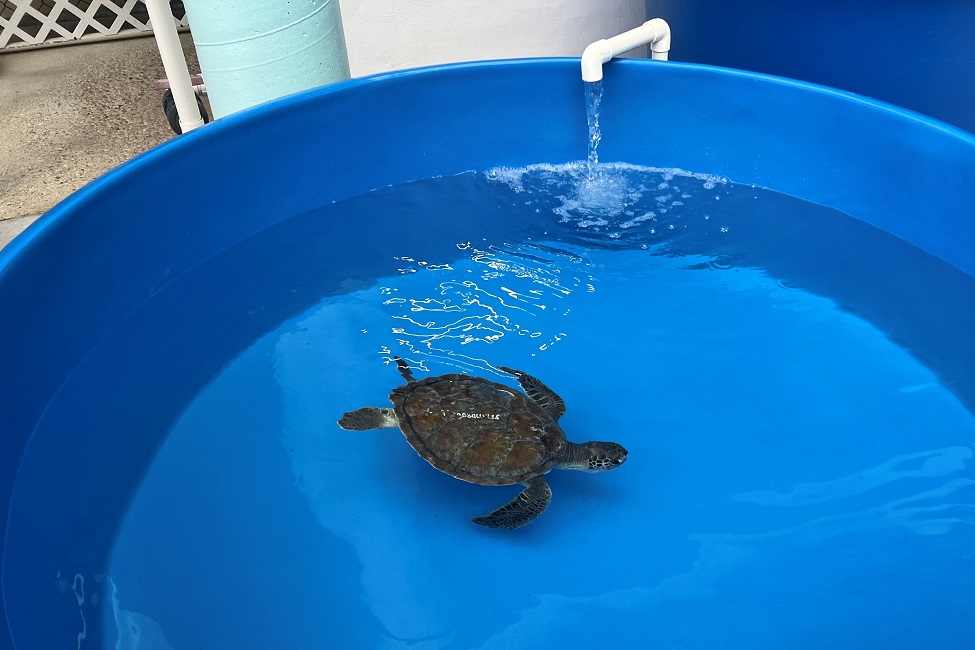Sunlight’s Healing Effects Help Green Sea Turtles With Tumors

A green sea turtle at a rehabilitation facility suffers from fibropapillomatosis, a disease that causes the growth of large debilitating tumors on the skin, eyes and shell. (Photo credit: Victoria E. Garefino)
A new study by Florida Atlantic University researchers is literally shedding “light” on a way to improve the health of endangered green sea turtles (Chelonia mydas) prone to a disease called fibropapillomatosis. Affecting about 60 percent of sea turtles in some sub-populations, juveniles are most susceptible to this disease that causes the growth of large debilitating tumors on the skin, eyes and shell.
Turtles with fibropapillomatosis are treated at rehabilitation facilities where the tumors are surgically removed. Unfortunately, many of them do not survive or the tumors regrow.
One solution to helping this population of sea turtles could be as simple as sunlight. Many turtle rehabilitation facilities have enclosures that limit sea turtles’ exposure to natural ultraviolet (UV) light. Rays from sun exposure are an important source of vitamin D, which is an essential nutrient in vertebrates that plays many physiological roles. Importantly, sea turtles with fibropapillomatosis show reduced vitamin D levels and variations in blood chemistry parameters.
For the study, FAU researchers compared vitamin D levels in green sea turtles with and without evident fibropapillomatosis to determine if exposure to sunlight would influence vitamin D levels and other health parameters. They also examined differences between turtles brought in to rehabilitation facilities and healthy wild-caught juvenile green turtles.
In addition, researchers investigated if higher levels of sun exposure increase vitamin D levels in sea turtles undergoing treatment for fibropapillomatosis compared to turtles receiving less ultraviolet light. Since turtles both with and without visible tumors entered the rehabilitation facility, researchers also checked to see if there was any correlation between sun exposure, vitamin D and tumor regrowth.
Turtles receiving treatment were housed in tanks exposed to higher or lower levels of sunlight for up to six months. Researchers looked at hematology and blood chemistry parameters and vitamin D, parathyroid hormone (regulates calcium levels in the blood) and ionized calcium levels. Turtles that had tumor removal surgery were monitored for any regrowth.
Results of the study, published in the journal Animals , revealed that turtles exposed to greater sunlight showed greater increases in plasma vitamin D and a more successful recovery. Vitamin D levels increased over time in turtles in rehabilitation with the most significant increases seen when the turtles were exposed to higher levels of UV light and for longer times. Those turtles kept in the sun tanks experienced less regrowth of tumors compared to those exposed to low UV light conditions. The results suggest that increasing sun exposure in rehabilitation facilities may enhance health and recovery in green sea turtles with fibropapillomatosis.
Upon intake, tumored turtles had lower plasma vitamin D and ionized calcium levels and higher parathyroid hormone levels when compared to both wild-caught and rehabilitation turtles without evident tumors.
“Data from our study suggest that one potential method to better the outcome of sea turtles with this disease is to increase their exposure to UV light during rehabilitation,” said Sarah L. Milton, Ph.D., senior author, chair and professor, Department of Biological Sciences, FAU Charles E. Schmidt College of Science, and a member of the FAU Stiles-Nicholson Brain Institute and FAU Institute for Human Health and Disease Intervention (I-Health). “Although a cure for this disease has yet to be discovered, we have shown that exposure to higher UV light increases vitamin D in turtles, as it does in other animals including humans. Increased plasma vitamin D levels are then in turn correlated with lower rates of disease. This potential to boost health could therefore contribute to improved recovery. For future studies, we would be interested to see if there are direct links between vitamin D levels and immune function.”
Study co-author is Victoria E. Garefino, an FAU graduate of Milton’s laboratory. This research was funded by Friends of Gumbo Limbo and National Save the Sea Turtle Foundation grants awarded to Milton.

-FAU-
Tags: jupiter | science | students | research | faculty and staff